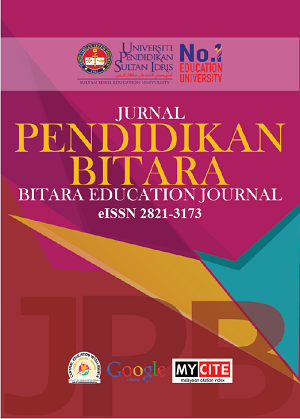Curriculum Evaluation on National Standard Pre-School of Islamic Education Component
Penilaian Kurikulum Standard Prasekolah Kebangsaan (Semakan 2017) Komponen Pendidikan Islam
DOI:
https://doi.org/10.37134/bitara.vol15.2.7.2022Keywords:
Implementation, Evaluation, Preschool Education, Preschool Curriculum, Islamic Education ComponentAbstract
The effectiveness of curriculum implementation can be seen when the curriculum developed is able to achieve the goals within the set period. In order to obtain information related to the implementation of the curriculum, the evaluation of the curriculum needs to be carried out holistically including various aspects. This coincides with the purpose of curriculum evaluation which is to determine whether the curriculum objectives have been implemented or achieved the desired results. There are several models that are often used to evaluate the curriculum. Each model has strengths and weaknesses. The decision to select a model to evaluate the curriculum is determined based on the purpose of the evaluation. Therefore, this concept paper aims to review the models related to curriculum evaluation and identify the appropriate model to evaluate the preschool curriculum component of Islamic Education. In the future, it is hoped that more studies related to preschool curriculum evaluation will be carried out to improve the preschool education curriculum in Malaysia.
Downloads
References
Aziz, S., Mahmood, M., & Rehman, Z. (2018). Implementation of CIPP Model for Quality Evaluation at School Level: A Case Study. Journal of Education and Educational Development, 5(1), 189. https://doi.org/10.22555/joeed.v5i1.1553
Bahagian Pembangunan Kurikulum, K. (2017). Kurikulum Standard Prasekolah Kebangsaan (Pendidikan Prasekolah; Dokumen Standard Kurikulum dan Pentaksiran Semakan 2017). Bahagian Pembangunan Kurikulum, 1–172. http://bpk.moe.gov.my/index.php/terbitan-bpk/pra-sekolah/category/40-dskp
Hamdan, A. R. (2007). Pengajian Kurikulum. Penerbit Universiti Teknologi Malaysia.
Hasyim, J., & Ari, A. ’. (2020). Evaluation of Child-Friendly Schools Program in Islamic Schools using the CIPP Model Dinamika Ilmu. 20(2), 323. https://doi.org/10.21093/di.v20i2.2580
Jaafar, A. (2015). Penilaian Pelaksanaan Kurikulum Islam Sekolah Menengah Berasaskan Model Context-Input-Process-Product (CIPP ).
Jaafar, A. (2019). Asas pembangunan kurikulum dalam pendidikan. Kuala Lumpur: Dewan Bahasa dan Pustaka.
Lucidea. (2021). The CIPP Model of Evaluation | Lucidea. Lucidea.Com. https://lucidea.com/blog/the-cipp-model-of-evaluation/
Mahmud, A. (2012). Konsep dan Penilaian Dalam Pelaksanaan Kurikulum. Prosididng Seminar Penyelidikan Pendidikan Dan Pembangunan Sumber Manusia (PPPSM 2013). https://doi.org/10.13140/RG.2.1.1752.2000. https://doi.org/https://doi.org/10.13140/RG.2.1.1752.2000
Malaysia, K. P. (2016). Surat Pekeliling Ikhtisas Bilangan 7 Tahun 2016 - Pelaksanaan Kurikulum Standard Prasekolah Kebangsaan (Semakan 2017). https://www.moe.gov.my/pekeliling/1943-surat-pekeliling-ikhtisas-bilangan-7-tahun-2016-pelaksanaan-kurikulum-standard-prasekolah-kebangsaan-semakan-2017/file
Mohamad Fadzil Che Amat, & A. J. A. H. (2013). Menilai keberkesanan pelaksanaan program diploma perguruan lepas ijazah pendidikan Sejarah sekolah rendah di institut pendidikan guru kampus Pulau Pinang. Kertas Kerja dibentangkan pada seminar pendidikan Sejarah dan Geografi di Universiti Malaysia Sabah.
Nor Hayati, & Bani Hidayat. (2016). Penilaian Pelaksanaan Kurikulum, Satu Sorotan. Journal of Islamic and Arabic Education, 8(2), 1–9.
Olivia, P. F. (2005). Developing the curriculum. Boston: Allyn & Bacon.
Shamsa Aziz, Munazza Mahmood, & Z. R. (2018a). Implementation of CIPP Model for Quality Evaluation at School Level: A Case Study. Journal of Education and Educational Development, 5(1), 189-206.
Shamsa Aziz, Munazza Mahmood, & Z. R. (2018b). Implementation of CIPP Model for Quality Evaluation at School Level: A Case Study. Journal of Education and Educational Development, 5(1), 189-206. https://files.eric.ed.gov/fulltext/EJ1180614.pdf
Stuffebeam, D. L. (1971). “The Relevance of the CIPP Evaluation Model for Educational Accountability.” Journal of Research and Development in Education,.
Stufflebeam, D., & Shinkfield, A. (2007). Evaluation Theory, Models, and Applications. In Jossey-Bass A Wiley Imprint San Francisco. https://scholarworks.wmich.edu/books/198
Surendran, S., & Norazlinda, S. (2019). Penilaian Program Sarjana Muda Pendidikan: Model CIPP Sebagai Asas. International Journal of Modern Trends in Social Sciences, 2(8), 132-140. https://doi.org/10.35631/IJMTSS.280013
Thurab-Nkhosi, D. (2019). The evaluation of a blended faculty development course using the CIPP Framework.
Trends, C. (2007). Why conduct a program evaluation? Research to Results, 31.
Tyler, R. . . (1949). Basic principles of curriculum and instruction. Chicago : University of Chicago.
Downloads
Published
Issue
Section
License
Copyright (c) 2022 Mohd Azahar Madar, Mohd Syaubari Othman

This work is licensed under a Creative Commons Attribution-NonCommercial-ShareAlike 4.0 International License.





